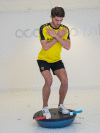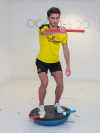Principles of Motor Learning to Support Neuroplasticity After ACL Injury: Implications for Optimizing Performance and Reducing Risk of Second ACL Injury
- PMID: 30719683
- PMCID: PMC6548061
- DOI: 10.1007/s40279-019-01058-0
Principles of Motor Learning to Support Neuroplasticity After ACL Injury: Implications for Optimizing Performance and Reducing Risk of Second ACL Injury
Erratum in
-
Correction to: Principles of Motor Learning to Support Neuroplasticity After ACL Injury: Implications for Optimizing Performance and Reducing Risk of Second ACL Injury.Sports Med. 2019 Jun;49(6):979. doi: 10.1007/s40279-019-01078-w. Sports Med. 2019. PMID: 30788801 Free PMC article.
Abstract
Athletes who wish to resume high-level activities after an injury to the anterior cruciate ligament (ACL) are often advised to undergo surgical reconstruction. Nevertheless, ACL reconstruction (ACLR) does not equate to normal function of the knee or reduced risk of subsequent injuries. In fact, recent evidence has shown that only around half of post-ACLR patients can expect to return to competitive level of sports. A rising concern is the high rate of second ACL injuries, particularly in young athletes, with up to 20% of those returning to sport in the first year from surgery experiencing a second ACL rupture. Aside from the increased risk of second injury, patients after ACLR have an increased risk of developing early onset of osteoarthritis. Given the recent findings, it is imperative that rehabilitation after ACLR is scrutinized so the second injury preventative strategies can be optimized. Unfortunately, current ACLR rehabilitation programs may not be optimally effective in addressing deficits related to the initial injury and the subsequent surgical intervention. Motor learning to (re-)acquire motor skills and neuroplastic capacities are not sufficiently incorporated during traditional rehabilitation, attesting to the high re-injury rates. The purpose of this article is to present novel clinically integrated motor learning principles to support neuroplasticity that can improve patient functional performance and reduce the risk of second ACL injury. The following key concepts to enhance rehabilitation and prepare the patient for re-integration to sports after an ACL injury that is as safe as possible are presented: (1) external focus of attention, (2) implicit learning, (3) differential learning, (4) self-controlled learning and contextual interference. The novel motor learning principles presented in this manuscript may optimize future rehabilitation programs to reduce second ACL injury risk and early development of osteoarthritis by targeting changes in neural networks.
Conflict of interest statement
Alli Gokeler, Dorothee Neuhaus, Anne Benjaminse, Dustin Grooms, and Jochen Baumeister declare that they have no potential conflicts of interests relevant to the content of this manuscript.
Figures




Similar articles
-
Limb Symmetry Indexes Can Overestimate Knee Function After Anterior Cruciate Ligament Injury.J Orthop Sports Phys Ther. 2017 May;47(5):334-338. doi: 10.2519/jospt.2017.7285. Epub 2017 Mar 29. J Orthop Sports Phys Ther. 2017. PMID: 28355978 Free PMC article.
-
Feedback techniques to target functional deficits following anterior cruciate ligament reconstruction: implications for motor control and reduction of second injury risk.Sports Med. 2013 Nov;43(11):1065-74. doi: 10.1007/s40279-013-0095-0. Sports Med. 2013. PMID: 24062274 Free PMC article.
-
Report of the Clinical and Functional Primary Outcomes in Men of the ACL-SPORTS Trial: Similar Outcomes in Men Receiving Secondary Prevention With and Without Perturbation Training 1 and 2 Years After ACL Reconstruction.Clin Orthop Relat Res. 2017 Oct;475(10):2523-2534. doi: 10.1007/s11999-017-5280-2. Clin Orthop Relat Res. 2017. PMID: 28224443 Free PMC article. Clinical Trial.
-
Should Return to Sport be Delayed Until 2 Years After Anterior Cruciate Ligament Reconstruction? Biological and Functional Considerations.Sports Med. 2017 Feb;47(2):221-232. doi: 10.1007/s40279-016-0584-z. Sports Med. 2017. PMID: 27402457 Free PMC article. Review.
-
Optimization of the Return-to-Sport Paradigm After Anterior Cruciate Ligament Reconstruction: A Critical Step Back to Move Forward.Sports Med. 2017 Aug;47(8):1487-1500. doi: 10.1007/s40279-017-0674-6. Sports Med. 2017. PMID: 28078610 Review.
Cited by
-
Visual Perturbation to Enhance Return to Sport Rehabilitation after Anterior Cruciate Ligament Injury: A Clinical Commentary.Int J Sports Phys Ther. 2021 Apr 1;16(2):552-564. doi: 10.26603/001c.21251. Int J Sports Phys Ther. 2021. PMID: 33842051 Free PMC article.
-
Protocol for double-blinded randomized trial to enhance postural control after anterior cruciate ligament reconstruction by balance training and concurrent cognitive demands or external focus of attention.Eur J Transl Myol. 2023 Mar 10;33(1):11085. doi: 10.4081/ejtm.2023.11085. Eur J Transl Myol. 2023. PMID: 36919557 Free PMC article.
-
Finishing stationary cycling too early after anterior cruciate ligament reconstruction is likely to lead to higher failure.BMC Sports Sci Med Rehabil. 2021 Nov 25;13(1):149. doi: 10.1186/s13102-021-00377-y. BMC Sports Sci Med Rehabil. 2021. PMID: 34823577 Free PMC article.
-
Real-time biofeedback integrated into neuromuscular training reduces high-risk knee biomechanics and increases functional brain connectivity: A preliminary longitudinal investigation.Psychophysiology. 2020 May;57(5):e13545. doi: 10.1111/psyp.13545. Epub 2020 Feb 13. Psychophysiology. 2020. PMID: 32052868 Free PMC article.
-
Anodal transcranial direct current stimulation (tDCS) modulates quadriceps motor cortex inhibition and facilitation during rehabilitation following anterior cruciate ligament (ACL) reconstruction: a triple-blind, randomised controlled proof of concept trial.BMJ Open Sport Exerc Med. 2024 Dec 9;10(4):e002080. doi: 10.1136/bmjsem-2024-002080. eCollection 2024. BMJ Open Sport Exerc Med. 2024. PMID: 39659706 Free PMC article.
References
-
- van Melick N, van Cingel RE, Brooijmans F, Neeter C, van Tienen T, Hullegie W, et al. Evidence-based clinical practice update: practice guidelines for anterior cruciate ligament rehabilitation based on a systematic review and multidisciplinary consensus. Br J Sports Med. 2016;50(24):1506–1515. doi: 10.1136/bjsports-2015-095898. - DOI - PubMed
Publication types
MeSH terms
LinkOut - more resources
Full Text Sources
Medical

